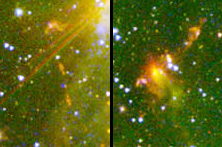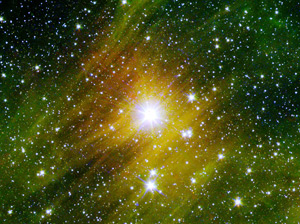For centuries, scientists have wondered how stars were born. There were lots of ideas, but precious little evidence to back them up.
That’s changed recently. Oh baby, how that’s changed. Check out this gorgeous image of the star-forming compact gas cloud called GL490:
You have to click that to get the ginormous 6000 x 6000 pixel version! It’s stunning.
This image is a combination of pictures taken by the Spitzer Space Telescope and the 2 Micron All-Sky Survey, or 2MASS. Both telescopes scan the sky in the infrared, well outside what our eyes can see. In this false-color image, blue represents 2.2 microns (the reddest light our human eyes can detect is about 0.7 microns, so this is three times that wavelength), green is 3.6 microns, and red is 4.5 microns. At these long wavelengths, what you tend to see are objects that astronomers call “warm”, but that’s compared to empty space. In non-geek terms, these objects are colder than 100 Kelvin: about -170°C, or -280°F!
The green glow is from PAHs, or polycyclic aromatic hydrocarbons. Again, in non-geek lingo: big molecules of stinky soot. These are created in lots of conditions in space, but are common where stars are being born. Another indication we’re seeing star birth here is that the cloud is pumping out infrared light: it glows in the IR with thousands of times the Sun’s total energy, which is what you expect if young, hot stars are embedded in thick layers of dust. The dust absorbs that light, warms up, and glows in the IR.
And we know the dust is incredibly thick: it stops so much visible light that if you were to create a filter with the same light-blocking ability, it would be darker than a welder’s mask. If you walked outside and held it up, it would totally prevent any sunlight from reaching your eyes. If you were to ask how much more black it could be, the answer would be none: none more black.
 But in the infrared GL490 glows! And that glow reveals a lot about what’s going on. There are little blobs of material all over the cloud, like the two shown here. See how the blobs tend to line up, like a stream of glop in space? That’s yet another indication we’re seeing young stars. When a star is born, it spins rapidly, has strong magnetic fields, and is generally surrounded by a disk of material from which it (and maybe any planets it has) formed. This sets up conditions where twin beams (what astronomers call “jets”) of matter can be blown out of the star from its poles. Since the gas is moving outward from the poles, it’s called bipolar outflow*.
But in the infrared GL490 glows! And that glow reveals a lot about what’s going on. There are little blobs of material all over the cloud, like the two shown here. See how the blobs tend to line up, like a stream of glop in space? That’s yet another indication we’re seeing young stars. When a star is born, it spins rapidly, has strong magnetic fields, and is generally surrounded by a disk of material from which it (and maybe any planets it has) formed. This sets up conditions where twin beams (what astronomers call “jets”) of matter can be blown out of the star from its poles. Since the gas is moving outward from the poles, it’s called bipolar outflow*.
In some cases there are clearly jets of matter coming from the stars, but using radio telescopes astronomers have looked at GL490 and seen that some of the outflow is perhaps not as well focused. Some stars may be blowing vast winds, like the solar wind, in all directions which expand and sweep up the gas around them. Blobs also seen to emit radio waves may be clumps of that material as it gets snowplowed by the spherically-expanding winds.
 Also, I have to point out the very cool star near the top of the image. See how it’s surrounded by a yellower dust (remember, these are false colors; the green is really way out in the IR, and the yellow not quite so far)? That’s probably not the dust glowing, but reflecting the light from the star itself. Some objects in space glow on their own, and some are bright because they’re lit up by something bright nearby. That latter is the case here.
Also, I have to point out the very cool star near the top of the image. See how it’s surrounded by a yellower dust (remember, these are false colors; the green is really way out in the IR, and the yellow not quite so far)? That’s probably not the dust glowing, but reflecting the light from the star itself. Some objects in space glow on their own, and some are bright because they’re lit up by something bright nearby. That latter is the case here.
Interestingly, the dust appears to be laid out in long, thin ribbons. That may be due to the star’s magnetic field; the dust grains line up along the field lines like iron filings on paper with a magnet underneath. I’ll also note that if you look at the big picture, that star appears to be near the center of a huge, battered loop of dust. I suspect it’s a young star blowing out a wind that’s sweeping up the material in the cloud, carving out that cavity. I can’t be positive though, since it may simply be a coincidental distribution of dust in the cloud… but it appears to be happening on a smaller scale around at least one other star in that cloud, too.
Obviously, there’s a lot going on here! The good news is that GL490 is relatively close – about 3000 light years – which gives us a pretty good view of what it’s doing. Amazingly, the Spitzer data was taken after the telescope had run out of the helium coolant it used to keep its cameras cold; since it’s looking at cold objects, the mirror itself had to be kept cold or else it would’ve been like shining a flashlight down the tube! So even though the helium ran out a while back, Spitzer is still capable of producing great science, and very, very pretty imagery.
And if you like this, I strongly urge you to take a look at the Related Posts below. Each shows incredible infrared images of the sky, some of which are destined to be your new desktop wallpaper.
Image credit: NASA/JPL-Caltech/2MASS/B. Whitney (SSI/University of Wisconsin)
* Which is also the term used when astronomers get food poisoning or a norovirus.
Related posts:
- When a star struggles to be free of its chrysalis
- The unfamiliar face of beauty
- The terrible beauty of star birth
- The first spectacular views of the sky from WISE